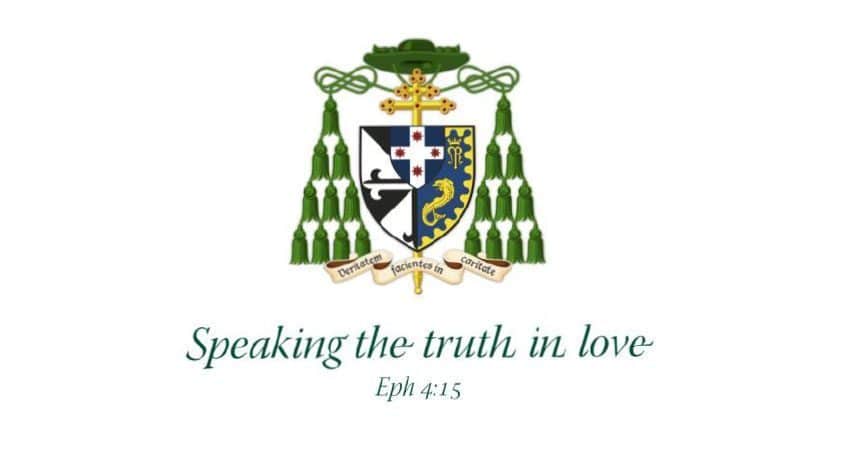HOMILY FOR MASS OF THE MOST HOLY BODY AND BLOOD OF CHRIST

Chapel of Our Lady of the Rosary and St Peter Chanel, Domus Australia, Rome Corpus Christi Year C
What are they staring at? In Paul Newton’s painting of The Catholic Community in Sydney c. 1818 the youngest are the most intensely focused on what they would have called ‘the Blessed Sacrament’. The older faithful smile with delight or are wrapped in the mystery of the Real Presence. Some are contemplating their harsh fate on the other side of the world from their homelands, without priest or Mass, their only consolation a host left in a pyx by a renegade priest as he was expelled from the colony.
Today’s Gospel story,The Feeding of the Five Thousand (Lk 9:11-17) prefigures the Eucharist. First, Jesus preaches at length, possibly for several hours [It’s tempting…]. When the apostles draw His attention to the late hour, He divides the diocese of 5,000 into parishes of fifty or so for Mass. Then He raises His eyes to heaven and blesses the elements. He performs the fraction and has them distribute the elements to the crowd. And He directs that the leftovers be reverently collected up. We already have the first rubrics for the sacred liturgy, but still we ask: what are they staring at? What is the meaning of this ceremony?
Well, one thing is clear: that the Eucharist is for when things are hard, too hard, impossible. Statisticians from the Judean Centre for Pastoral Research and auditors from the Palestinian Conference Review of Finances come to Jesus today to say there are only five loaves and two fish in the Church coffers – that is, 0.1% of a loaf per person and 0.04% of a fish. There aren’t enough priests to go around, or lay leaders, or serious Catholic teachers, or resources, or volunteers, or indeed faith and enthusiasm. Just like in early Australia. But it’s when things are that tough that it’s time for Mass – like on the night He was betrayed. St Thomas Aquinas’ glorious sequence Lauda Sion sings the praises of the Sacred Banquet but hints at a darker context: of the night of ancient paschal sacrifice, of young Isaac laid upon an altar, of disciples baffled and grieving, of communion for spiritual life or ghostly death.
Today the bishops tell the Lord that feeding this mob is beyond them and suggest He sends them away. Jesus responds by telling them to give it a go, with whatever is left in their tanks. He takes the little they offer and supplies the rest that is needed. Enough, more than enough, superabundance: twelve basketsful of leftover graces, one for each apostle and his successors.
Titled simply Love, George Herbert’s poem perfectly captures this movement of grace, of sin abounding but grace abounding the more, of pusillanimous humanity and magnanimous God, of hunger sated by gracious magnificence:
Love bade me welcome; yet my soul drew back,
Guilty of dust and sin.
But quick-ey’d Love, observing me grow slack
From my first entrance in,
Drew nearer to me, sweetly questioning
If I lack’d anything.
This is, of course, Christ’s Eucharistic call, Love bidding us welcome. Do you, does humanity, lack anything, anything needed for true happiness? Then Church, pastors, disciples: you must provide it. For the hungry crowd. For all humanity. No more pessimism or slackness. I will multiply your efforts.
What holds us back?
‘A guest,’ I answer’d, ‘worthy to be here:’
Love said, ‘You shall be he.’
‘I, the unkind, the ungrateful? Ah my dear,
I cannot look on thee.’
Love took my hand and smiling did reply,
‘Who made the eyes but I?‘
Knowing our personal limitations, ashamed of our institutional failIngs and cowed by a hostile mob, we say to God non sum dignus, we’re not up to so big a task. But Love brushes away these anxieties. Our eyes are made for this, above all: to look upon the face of God and live. As Steve Agrisano explained so beautifully to our young ones at the Australian Catholic Youth Festival: Eucharistic Adoration is me looking at God and God looking at me. “So I gaze on you in the sanctuary, my lips speak your praise, my soul filled as with a banquet.”(Ps 62)
Yet hungry as we are for God, and aware that He made us to gaze on Him, we are stubborn in our shame and distraction, attached to our demoralisation, and in Herbert’s poem we answer:
‘Truth, Lord, but I have marr’d them; let my shame
Go where it doth deserve.’
‘And know you not,’ says Love, ‘Who bore the blame?’
‘My dear, then I will serve.’
‘You must sit down,’ says Love, ‘and taste my meat.’
So I did sit and eat.
At every Mass we join the centurion declaring “Lord, I am not worthy” but are reminded that God gave His only Son, body and soul, flesh and blood, humanity and divinity, to be always present to us, as our thanksgiving and service, our supper and salvation, our source and summit, our communion with eternity. What those first four Australian-born Catholic children in our painting grasped in their innocence was this. Even as we older faithful seek to engage in divine service, God sits us down to ‘taste his meat’. At last we surrender, both our inadequacy and our adequacy, both our sinfulness and our service.
As our time with the Holy Father and his helpers approaches, and with the Plenary Council on the near horizon, we bishops acknowledge many challenges. There is nothing Polyannaish in Our Eucharistic faith, as it recalls the apostacy of Jesus’ Last Night, its portents of flesh torn and blood spilt the next day, the near-extinction of bread and wine as they are transformed into more and better, the near-annihilation of ourselves, too, as we are transubstantiated by sanctifying grace, so that “it is no longer me that lives, but Christ who lives in me” – with just the aging accidents of my old self remaining.
Yet it’s precisely when we are at our lowest ebb that the triumph of grace is most evident. In my own Archdiocese of Sydney, where those first lay faithful kept the faith alive by praying before the Blessed Sacrament, the numbers attending our annual Corpus Christi procession through the streets keeps growing, despite pressures to drive the Church into obscurity. At the very time that human reasoning counts against any sane man giving his life to this rickety show, my seminary is the fullest it has been since it was rebuilt in the 1990s and one of my happy duties on my return will be to ordain seven priests. The hunger for the Eucharist has always been great in our land. And so we can sing, as we do in the Sequence, of the rising day that dispels the night, of the living food that feeds the deepest hunger, of the host that saves when all seems lost:
Behold the Bread of Angels sent,
to your Church in her banishment,
the Bread for God’s true children meant.
Come then, Good Shepherd, Bread divine:
still show thy sheep your mercy sign;
feed too, your shepherds, keep us thine.
INTRODUCTION TO MASS OF THE MOST HOLY BODY AND BLOOD OF CHRIST
Chapel of Our Lady of the Rosary and St Peter Chanel, Domus Australia, Rome Corpus Christi Year C
Welcome to the Chapel of Our Lady of the Rosary and St Peter Chanel for our celebration of Mass for the Solemnity of the Body and Blood of Christ.
I acknowledge concelebrating with me today the bishops of Australia, currently in Rome for their visit ad limina apostolorum. The last time we gathered here it was during our ad limina eight years ago, when Pope Benedict blessed and officially opened the house. Welcome back dear brothers to your home away from home here in Rome!
I salute the Rector, Monsignor John Boyle, with other resident clergy and staff of Domus Australia who have made us so welcome. I also acknowledge our several Australian priests, seminarians and lay people stationed in Rome for work, study or conferencing: in particular Her Excellency the Australian Ambassador to the Holy See, Melissa Hitchman, with Dr Adrian Hitchman; rectors of Australian seminaries; leaders and students from the Australian Catholic University; youth attending the Eleventh International Youth Forum; and staff of the Australian Catholic Bishops Conference and the Archdiocese of Sydney. To all others present today, both visitors and locals, a very warm welcome!
In awe and gratitude for the Sacred Body and Precious Blood, let us now prepare ourselves to celebrate the Sacred Mysteries…

